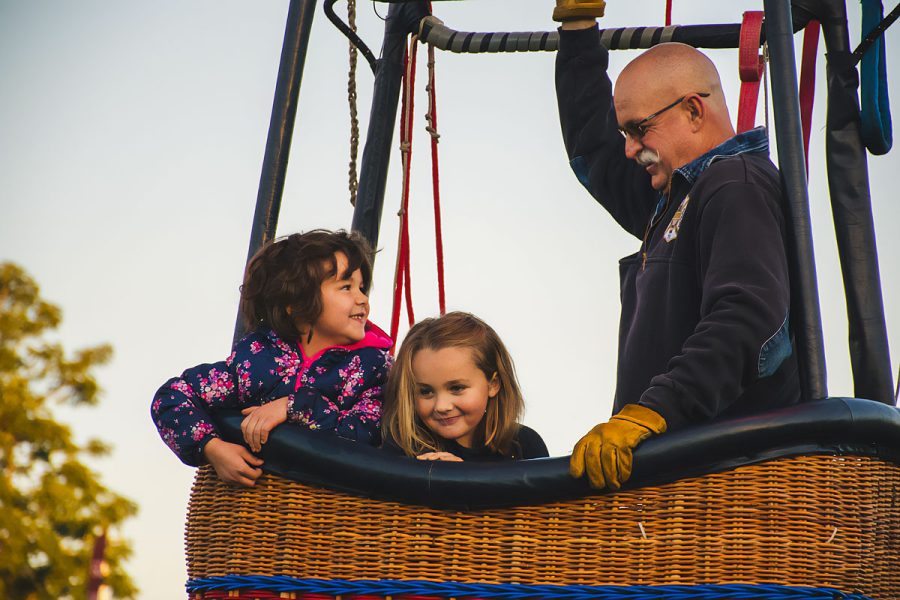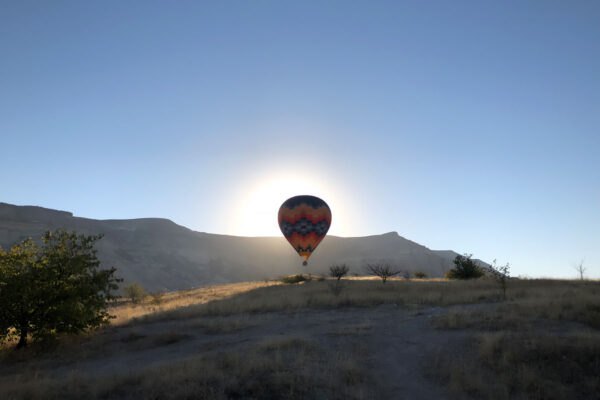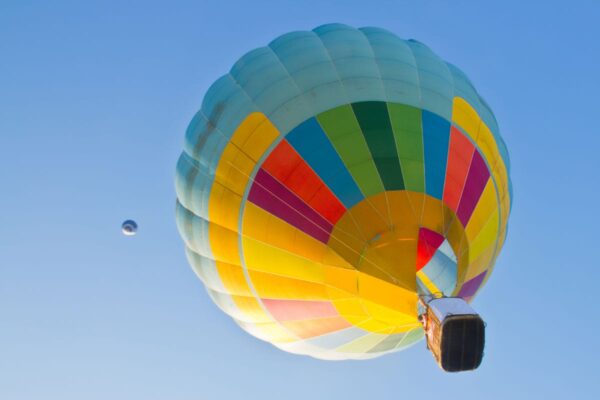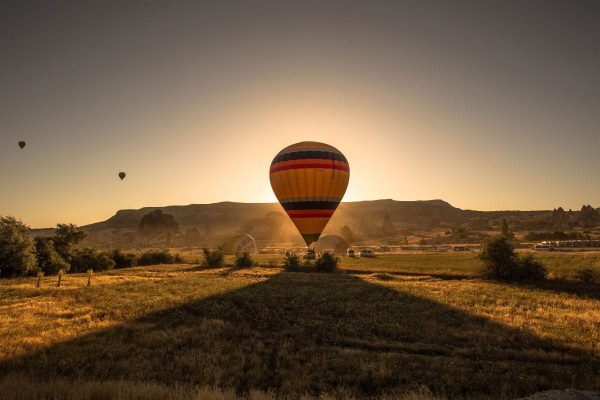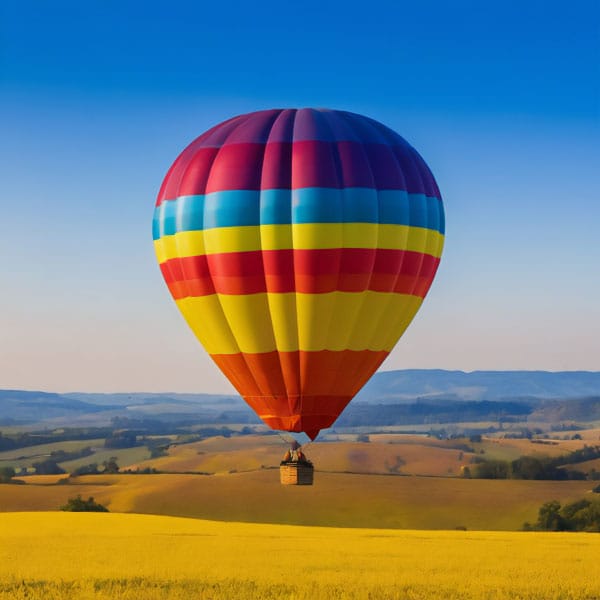Planning the first balloon flight is a chance to introduce your child to a sky-high adventure. Such a trip gives the opportunity to observe the landscape from a great height. It can also impart knowledge about weather phenomena, physics and the environment.
However, it requires good organization. You need to take into account the age of the child, choose the right date and place. It is also necessary to take care of his well-being and sense of security.
Good preparation will make the flight a unique experience. Such an adventure can be memorable for a long time and awaken curiosity about the world.
Preparation for a balloon flight with a child
The organization of the first balloon flight with a child requires a thorough plan. The goal is to ensure that the event takes place safely and calmly. It is crucial to choose an operator with experience in flying with children. Check reviews from families and make sure the company follows safety regulations.
It is best to make reservations several months in advance. Most companies provide vouchers valid for a year. This makes it easier to choose the right day in terms of weather. When making a reservation, you need to declare the participation of a child. This will enable you to prepare the appropriate conditions.
Choice of season and day
The best time to fly with a child is late spring or early autumn. Then the temperature is mild and the weather is more predictable. In summer, morning flights can sometimes be uncomfortable because of the heat.
Flights usually take place at sunrise or sunset. Evening flights are more convenient because they don’t require getting up early. Sunset also provides spectacular views that can delight a child.
Check the weather forecast before booking. Ballooning requires calm winds, no precipitation and good visibility. The operator always evaluates conditions and can cancel the flight if the weather is not suitable.
The whole process takes about 3-4 hours, of which the flight takes about an hour. It is necessary to take this time into account to avoid exhaustion of the child.
Physical and mental preparation of the child
It is a good idea to startpreparing your child earlier. A few weeks before the flight, balloon photos and recordings will be helpful. Books or educational programs about balloons are also a good idea. It is necessary to explain how the balloon works and what will happen during the flight. The information must be understandable and age-appropriate. The sounds of the burner, which can be loud, should be mentioned.
Talking about fears can help reduce tension. Children are sometimes afraid of heights or a new situation. It is important to create space for open expression of emotions.
The child should be well rested before the flight. Sleep and a light meal before takeoff affect well-being. However, a meal that is too heavy may cause nausea.
The operator should be informed of the child’s special needs. These include, for example, allergies, illnesses or fears. The staff will then prepare appropriate conditions.
It is important to check the requirements for children. Some companies expect a certain height or weight. The minimum height is usually about 1.2 meters, so that the child can look over the basket.
Elements to check before choosing a balloon flight operator:
- Experience of the pilot and company in organizing flights with children
- Certifications and licenses held
- Safety history
- Reviews from other families who have used the service
- Availability of special facilities for children
Safety rules for balloon flights for families
Safety is the most important aspect of a balloon flight, especially one involving children. The International Aeronautical Federation (FAI) recognizes the hot air balloon as the safest aircraft. Nevertheless, rules must be strictly followed to ensure a smooth flight.
Balloon flights are subject to strict regulations. This is guaranteed by the presence of experienced pilots and the use of established procedures.
Before the flight, participants receive a detailed safety briefing. It covers boarding, behavior during the flight and action in emergency situations.
The pilot has full decision-making authority. He chooses the landing site and can make a technical landing if he deems it necessary.
Behavior in the balloon basket
There are clear rules during the flight. They are designed to protect all passengers. It is imperative to follow the pilot’s instructions.
In the basket, sudden movements must be avoided. Every action should be calm and thoughtful. Children, due to emotions, can be busy. One must be reminded to remain calm.
It is categorically forbidden:
- Smoking in or near the garbage can
- Throwing objects outside the basket
- Consuming alcohol before and during the flight
- Leaning over the edge of the basket
Taking pictures and admiring the view is allowed. However, it is necessary to hold the equipment in a safe manner, without putting it outside the basket. Dropping an object can endanger people on the ground.
In case of ill health, it is necessary to report it to the pilot immediately. In case of an emergency, each participant must remain calm and follow instructions.
Interesting fact: Balloon baskets are made of wicker, as this material absorbs shocks well during landing and improves safety.
Takeoff and landing procedures
Taking off and landing a balloon requires accuracy and planning. Both phases affect safety.
During takeoff, the pilot chooses an open space. The site must be free of trees, buildings and wires. He then checks the wind strength and direction, prepares the balloon and fills the shell with cold air.
Later, a burner heats the air, which lifts the shell. When the balloon stands upright and is stable, passengers can enter the basket.
Landing also requires care. The pilot chooses a clear area by analyzing the weather and terrain. He announces the approach to landing and gives instructions.
During the descent, he releases hot air, regulating the landing rate.
Before landing, passengers should:
- Assume a safe position, with legs slightly bent
- Hold on to the handles inside the basket
- Rest their backs against the padded wall
- Do not jump out of the basket without explicit instruction from the pilot
Adults should help children get into the correct position. After landing, children must remain close to their caregivers.
Special safety measures for children
The safety of children requires extra care. Children must be supervised by adults at all times.
During balloon inflation, often taking place before dawn, visibility is limited. Special care must be taken. Vehicles may move around the site. Children should stay only in safe areas.
Before the launch, children need to be prepared for the sound of the torch. The noise can be surprising. It is worth talking about it beforehand.
It is important that children do not touch the equipment. The burner is very hot and can cause burns.
When flying, children should:
- Stand in the center of the basket, away from the edges
- Hold on to the handles or hands of adults
- Communicate discomfort or fear
- Listen and follow the pilot’s instructions
After landing, the balloon is folded. The terrain may be uneven and covered with tall grass. Children should not move away or disturb the crew.
What are the age restrictions for children on balloon flights
Age restrictions for children vary depending on the operator and the country where the flight takes place. Most companies set a minimum age for safety and passenger comfort reasons. Knowing these rules helps when planning a family balloon trip.
The minimum age of a child allowed on a flight is usually between 5 and 7 years old. Some companies accept children as young as 3, while others require a minimum age of 10. Differences are due to internal safety rules and local regulations. Be sure to check the policies of your particular operator before booking.
Interesting fact: The oldest person to take a balloon flight was 100 years old. This shows that lower age limits exist, but upper limits depend on health.
Growth and physical limitations
In addition to age, a child’s height also matters. Balloon baskets are usually about 1.2 meters high. The child must be able to see over the edge of the basket. Most companies require a height of 110 cm to 135 cm.
The minimum height is important not only for safety reasons. A child who cannot see over the basket will not take full advantage of the views. This can cause boredom or disappointment.
The ability to stand continuously for the entire flight is also necessary. Flights last from 30 minutes to two hours. There are no seats in the basket. Younger children may have a problem with this.
Physical fitness is also important. The child must:
– Enter the basket independently (with the help of an adult)
– Maintain balance while flying
– Understand and follow the pilot’s instructions
– Assume the proper position during landing
Care and supervision requirements
Children of a certain age must be supervised by an adult. Most operators require a parent or guardian to be present for children under 12-13.
Teens ages 13-17 can sometimes fly alone. However, an adult must be present during other parts of the trip, such as transportation to the launch site or the post-flight ceremony. The rules depend on the operator.
The exact age and height of the child must be provided when booking. Some operators also ask for additional consent forms, especially for children in the lower age range.
You also need to assess the child’s emotional maturity. Some children experience fear of heights or anxiety.
Before flying, it’s a good idea to check whether the child:
- Handles new situations well.
- Remains calm during stressful moments.
- Follows rules and instructions.
- Does not have sudden emotional outbursts.
Special cases and exceptions
Some situations require individual assessment. The operator may consider the child’s maturity, height and fitness.
Balloon festivals often have stricter rules than regular flights. Sometimes a minimum age of 10 is required, even though the company usually allows younger children.
Additional consultation may be required for children with disabilities. The deciding factor is safety. The operator may refuse to participate if it believes the flight poses a risk.
Factors influencing the decision for children with special needs:
- Type of disability.
- Ability to understand and follow instructions.
- Ability to safely enter and exit the basket.
- Reactions to altitude and movement of the balloon
The final decision is always up to the pilot. Even if the child meets all the requirements, the pilot may refuse the flight for safety reasons.
What to take on a balloon flight with a child
Preparing equipment for a balloon flight with a child is an important part of a successful trip. The right set of things increases comfort, safety and enjoyment. A balloon flight involves not only the trip itself, but also prior preparations. It usually starts early in the morning and lasts several hours. So it is necessary to take everything that can be useful during the whole event.
A basic kit should include weather-appropriate clothing, snacks, drinks and things to protect from the sun. It’s also a good idea to bring something that will help your child remember the adventure and provide entertainment while you wait.
Clothing and footwear appropriate to the conditions
Clothing has a big impact on the comfort of the flight. Balloons usually take off at dawn or before sunset, when it can be cool. At high altitude, the temperature can be even lower than on the ground.
It is best to dress your child in layers, the so-called “onion”. The first layer should wick away moisture. The second is to retain heat. The third protects against the wind. Such clothing will ensure comfort throughout the flight.
Footwear must be covered, flat and comfortable. Sandals and flip-flops will not work. The best will be sports or trekking shoes, which will give stability when entering and exiting the basket and when landing.
In cold weather, they will come in handy:
- A hat to protect against heat loss
- Gloves, preferably with a touchscreen function
- A scarf or chimney
- Warm socks
In summer you will need protection from the sun. You should bring lightweight headgear with a visor or brim and sunglasses. At altitude, the sun’s rays are stronger, and a basket offers no protection.
UV sunscreen is essential all year round. Apply the cream to exposed skin before taking off. You also need to take it with you to reapply as needed.
Snacks and drinks
Balloon flight is a morning activity that requires getting up early. There is often no time for a full breakfast. The entire event, from preparation to return, takes a long time.
Light snacks will provide energy and won’t take up much space. They should not crumble, melt or spill. The following will work well:
- Cereal bars or dried fruit
- Whole grain crackers
- Nuts (if there are no allergies)
- Small sandwiches with dry ingredients
You also need to take care of hydration. It’s best to take water in a bottle with a spill-proof cover. Avoid carbonated drinks and juices, which can spill.
On a chilly morning, it’s a good idea to have a thermos of warm beverages. Tea with honey or cocoa warms up well before the start.
Interesting fact: The sense of taste works differently at altitude than on the ground. The change in pressure can weaken the perception of flavors. Snacks with intense flavor work better.
Accessories to enhance comfort and safety
A camera or smartphone with a good camera will preserve memories. It’s a good idea to protect your device from drops. A wrist lanyard or neck strap will come in handy. You need to make sure the battery is charged and there is room for photos.
If your child can tolerate noise badly, earplugs or soundproofing headphones will be a good option. A balloon burner can be loud and can scare you.
Items useful in a backpack:
- A small flashlight (if starting before dawn)
- Wet wipes
- A blanket or thermal mat (to use while waiting)
- A small backpack with the child’s trinkets
Pack everything compactly. There is little space in the basket of the balloon, and too much luggage gets in the way. It is best to use one undersized backpack that can be placed on the floor or hung inside the basket.
How to talk to your child before the first balloon flight
The mental preparation of the child is of great importance when organizing a balloon flight. Talking before the event affects the flight and the memories. The message should be tailored to age, personality and level of understanding. Such a conversation reduces anxiety, builds a positive attitude and teaches how to deal with new situations.
It is a good idea to start conversations a few weeks before the flight. This allows you to get used to the idea, ask questions and express concerns. Gradual communication works more effectively than a quick explanation just before the event.
Building positive expectations
The way a balloon flight is presented affects attitudes. It’s best to talk about the adventure as an opportunity to see the world from a different perspective. You can compare it to an expedition familiar from books or movies.
Videos and photos of balloon flights help you imagine what the whole adventure is like. It is good to choose materials that show calm, pleasant situations. Avoid extreme images that may cause fear.
Fun activities can help tame the idea of flight. A simple experiment with warm air, such as releasing a paper lantern under supervision, teaches and entertains. You can also build an imitation basket from a box or laundry basket and play pretend flight.
It is worth mentioning that taking part in a balloon flight is an interesting experience that you can tell others about. Being able to brag about the adventure is sometimes a motivation, especially for older children.
Interesting fact: The first balloon flight with passengers took place in 1783 in Paris. On board were a sheep, a duck and a rooster. Such a fact can make a conversation more interesting and engaging.
Addressing fears and anxieties
Children, despite their excitement, may feel anxious about flying. It is necessary to create space to freely express feelings and ask questions. Do not ignore fears, even if they seem illogical.
Many children are afraid of heights or worried about safety. It is good to say that the baskets have high walls and the pilot is experienced. Hot air balloons are considered safe means of transportation.
Some children feel anxious about physical sensations, such as a feeling in the abdomen when ascending. It is necessary to explain that balloon flight is calm and smooth, with no sudden movements.
Ways to address specific fears:
- Fear of heights: The safety basket has high walls. No need to look down.
- Fear of noise: The sound of a burner may be loud, but it is normal. You can practice plugging your ears beforehand.
- Fear of landing: Landing can be like driving over bumps. A pilot can land safely.
With severe fear, watching balloons from the ground can be a good solution. Balloon festivals often provide opportunities to watch takeoffs and landings. Such observation can be a good introduction to future flight.
Explaining the process and rules
Children feel more confident when they know the process of an event. A detailed description of the flight process can reduce stress and uncertainty. It is a good idea to introduce the entire process:
- Arrival at the launch site (usually in the morning)
- Unfolding the balloon
- Filling the balloon with cold air
- Heating the balloon with a burner
- Entering the basket
- Taking off and ascending
- Flight and enjoying the view
- Lowering the altitude
- Landing
- Folding the balloon
It should also be said that the flight depends on the weather. It can be postponed. Preparing for such an eventuality helps avoid disappointment.
It is equally important to discuss safety rules. It should be emphasized that the rules do not restrict, but protect all participants. The child should know that:
- It is necessary to listen to the pilot;
- Do not lean out of the basket;
- Hold on to the handles during takeoff and landing;
- Do not touch the burner or equipment without permission;
- Remain calm and avoid sudden movements.
Talking about the rules should have a positive tone. Following the rules allows you to fully enjoy the flight and the views, without focusing on the dangers.
What to expect throughout the balloon flight experience
A balloon flight is not just a flight, but an entire event consisting of several stages. The whole experience usually lasts 3-4 hours. The flight itself takes 45-90 minutes. Each stage has a different character and provides different experiences. Understanding the course of the event helps better prepare the child and increases the satisfaction of participation.
Flights usually take place at sunrise, when weather conditions are stable. This requires getting up very early. For children, this can be an exciting way to start the day when others are still asleep. The early hour can be presented as part of the adventure.
Preparing the balloon and taking off
Once you arrive at the launch site, you can watch the preparations for the flight. The process usually takes 20-40 minutes. Children enjoy watching the balloon being unfolded and inflated.
First, the basket is removed from the trailer and the burner is installed. Then the crew unfolds the balloon’s shell and connects it to the basket. Initially, the balloon is filled with cold air using a large fan. The balloon then takes on its full shape, which can be impressive for children.
Once the shell is partially filled, the pilot starts the burner. Flames and a loud sound appear. This moment can be intense. It can cause excitement and slight anxiety at the same time.
Once the balloon is upright, passengers enter the basket. Climbing over the side (about 1.2 meters) requires dexterity. Children usually need help. Before takeoff, the pilot communicates safety rules.
Interesting fact: During inflation, as much air is used as would fit in about 90,000 birthday balloons. The shell can hold from 2,000 to 7,000 cubic meters of air.
The flight itself – impressions and views
The launch is smooth. The balloon ascends smoothly and without jerks. Separation from the ground is sometimes imperceptible. There are no sudden movements in the balloon. There is no feeling of “butterflies in the stomach”.
During the flight there is silence. Only from time to time the bang of a burner can be heard as the pilot heats the air. The silence allows you to hear sounds from the ground: dogs barking, birds singing, people talking.
The views are exceptional. The balloon moves slowly and low, which allows you to observe the area closely. You can see familiar places from an unusual perspective. Children enjoy looking out over houses, schools or parks.
The temperature on board may surprise you. Although the balloon rises high, it is warm in the basket. A burner heats the space, and the lack of wind means you don’t feel the chill.
The pilot controls only the altitude. The direction is determined by the wind. The unpredictability of the landing site is part of the adventure. The pilot uses different layers of air to change the flight path.
Landing and ending the adventure
Landing can sometimes be the most exciting moment. The pilot chooses a location, taking into account terrain, obstacles and accessibility for the ground crew vehicle, which follows the route all the time.
A few minutes before landing, the passengers receive instructions. There are two types of landings:
- Vertical landing – the basket remains vertical, the balloon comes to a gentle stop;
- Stall landing – in stronger winds the basket can shift and tilt.
Both ways are safe. Landing with a stall can be more dynamic. Children who like excitement may find it an attraction. When landing, bend your knees, grab the handles and lean against the basket’s padding.
After landing, the folding of the balloon begins. The crew releases the air and folds the shell. The process can be interesting. Children often help, which is similar to rolling up a large sleeping bag.
Finally, a traditional ceremony takes place. The pilot tells the story of ballooning and hands out certificates for the first flight. For children it is a symbol of courage and a souvenir of the adventure.
Summary
A balloon flight with a child is a unique experience. It requires careful planning and preparation. Key elements:
Selecting an experienced operator with good reviews. Checking age and height restrictions. Adjusting the date to the weather and season.
Preparing the child physically and mentally. Talking about the flight and safety rules. Taming the idea through movies and games.
Appropriate equipment. Layered clothing, comfortable shoes, snacks and drinks. Accessories to enhance comfort and safety.
Following the rules during the flight. Listening to the pilot’s instructions, staying calm, avoiding sudden movements.
Such an adventure develops curiosity about the world, teaches a new view of the environment. It builds family bonds through shared experiences. It leaves unforgettable memories and can awaken a passion for aviation.
A balloon flight is not just an attraction, but a valuable lesson for a child. It teaches courage, confidence and coping with new situations.
